Cytokinesis often, but not always, accompanies _____.
A) Telophase
B) Anaphase
C) Metaphase
D)Interphase
E) Prometaphase
A
Chromosomes become visible during _____.
A)metaphase
B)interphase
C) prometaphase
D)anaphase
E) prophase
E
Centromeres divide and sister chromatids become full-fledged chromosomes during _____.
A)metaphase
B)interphase
C) prometaphase
D)anaphase
E) prophase
D
Spindle fibers attach to kinetochores during _____.
A)metaphase
B)interphase
C) prometaphase
D)anaphase
E) prophase
C
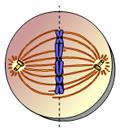
This animation illustrates the events of _____.
A)metaphase
B)interphase
C) prometaphase
D)anaphase
E) prophase
D
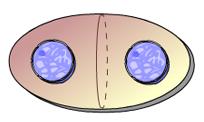
This animation illustrates the events of _____.
A) cytokinesis as it occurs in animal cells
B)prophase
C)prometaphase
D)cytokinesis as it occurs in plant cells
E) metaphase
A
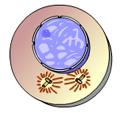
This animation illustrates the events of _____.
A)metaphase
B)interphase
C) prometaphase
D)anaphase
E) prophase
E
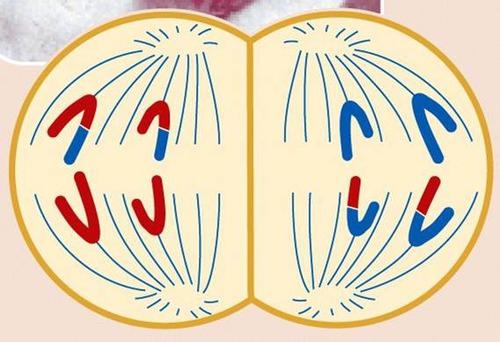
This animation illustrates the events of _____.
A)anaphase I
B) anaphase II
C) prophase II
D) interphase
E)telophase I and cytokinesis
B
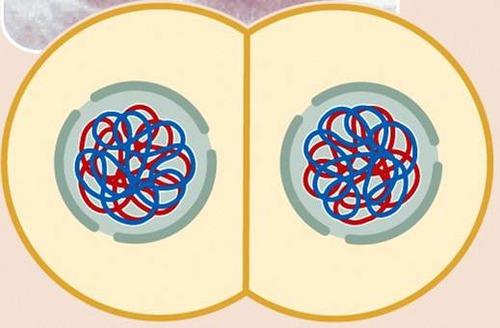
This animation illustrates the events of _____.
A)
prophase I
B) telophase II and cytokinesis
C) anaphase
II
D) prophase II
E) telophase I and cytokinesis
C
Gametes are produced by _____.
A) meiosis
B)
fertilization
C) mitosis
D) the cell cycle
E) asexual reproductionMeiosis
A
A diploid organism whose somatic (nonsex) cells each contain 32
chromosomes produces gametes containing _____ chromosomes.
A)
16
B) 8
C) 64
D) 30
E)32
A
Meiosis I produces _____ cells, each of which is _____.
A) four ... diploid
B) two... diploid
C) two...
identical to the other
D) four ... haploid
E) two ... haploid
E
Meiosis II typically produces _____ cells, each of which is _____.
A) four ... diploid
B) two... diploid
C) two... identical
to the other
D) four ... haploid
E) two ... haploid
D
During prophase, a homologous pair of chromosomes consists of _____.
A) ONE chromosome and two chromatids
B)ONE chromosome and four chromatids
C)TWO chromosomes and two chromatids
D)TWO chromosomes and four chromatids
E)four chromosomes and two chromatids
D
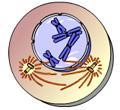
This animation illustrates the events of _____.
A) Telophase
B) Anaphase
C) Metaphase
D)Interphase
E) Prometaphase
E
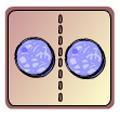
This animation illustrates the events of _____.
A) Telophase
B) Anaphase
C) Metaphase
D)cytokinesis as it occurs in plant cells
E) aNaphase
D
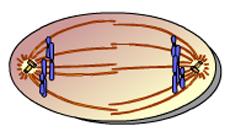
This animation illustrates the events of _____.
A) Telophase
B) Anaphase
C) Metaphase
D)Interphase
E) Prometaphase
A
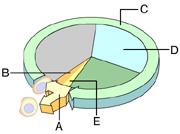
Which of these phases encompasses all of the stages of mitosis?
A)
B)
C)
D)
E)
E
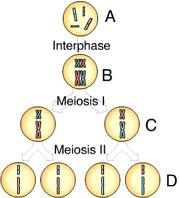
Which of these cells is (are) haploid?
A) C AND D
B) A AND B
C)B AND A
D)C AND D
E)D AND B
A
Which of the following is true of kinetochores?
Which of the following is true of kinetochores?
A)They interdigitate at the cell's equator and then move apart, causing the cell to elongate.
B)They are the primary centromere structures that maintain the attachment of the sister chromatids prior to mitosis.
C)They are sites at which microtubules attach to chromosomes.
D)they attach to the ring of actin along the cytoplasmic surface of the plasma membrane, causing the actin to contract to form the cleavage furrow
E) They are located at the center of the centrosome; their function is to organize tubulin into elongated bundles called spindle fibers.
C
In some organisms, such as certain fungi and algae, cells undergo the cell cycle repeatedly without subsequently undergoing cytokinesis. What would result from this?
A)a decrease in chromosome number
B)large cells containing many nuclei
C)division of the organism into many cells, most lacking nuclei
D)a rapid rate of gamete production
E)inability to duplicate DNA
B
22) Cells will usually divide if they receive the proper signal at a checkpoint in which phase of the cell cycle?
A)G2
B)S
C)M
D)G1
E)CYTOKINESIS
D
230Which of the following is true of benign tumors, but not malignant tumors?
A)They migrate from the initial site of transformation to other organs or tissues.
B)They remain confined to their original site
C)They are the result of the transformation of normal cells.
D)They can divide indefinitely if an adequate supply of nutrients is available.
E)They have an unusual number of chromosomes.
B
24)Through a microscope, you can see a cell plate beginning to develop across the middle of a cell and nuclei forming on either side of the cell plate. This cell is most likely
A)a plant cell in the process of cytokinesis.
B)an animal cell in the process of cytokinesis.
C)a plant cell in metaphase.
D)a bacterial cell dividing.
E)an animal cell in the S phase of the cell cycle.
A
25)In the cells of some organisms, mitosis occurs without cytokinesis. This will result in
A)destruction of chromosomes.
B)cell cycles lacking an S phase.
C)cells lacking nuclei.
D)cells that are unusually small.
E)cells with more than one
E
26)Which of the following does not occur during mitosis?
A)condensation of the chromosomes
B)separation of sister chromatids
C)separation of the spindle poles
D)replication of the DNA
E)spindle formation
D
27)The drug cytochalasin B blocks the function of actin. Which of the following aspects of the animal cell cycle would be most disrupted by cytochalasin B?
A)spindle formation
B)cleavage furrow formation and cytokinesis
C)spindle attachment to kinetochores
D)cell elongation during anaphase
E)DNA synthesis
B
28) Human gametes are produced by _____
A)meiosis
B) asexual reproduction
C)mitosis
D) fertilization
E) the cell cycle
A
29)Normal human gametes carry _____ chromosomes.
A)46
B)23 Pairs of
C)46 pairs of
D)5
E)23
E
30)Of the following, a receptor protein in a membrane that recognizes
a chemical signal is most similar to
A) RNA specifying
the amino acids in a polypeptide.
B) genes making up a
chromosome.
C) a particular metabolic pathway operating within a
specific organelle.
D) the active site of an allosteric enzyme
in the cytoplasm that binds to a specific substrate.
E) an
enzyme with an optimum pH and temperature for activity.
D
31)During which stage of mitosis do spindle microtubules first attach
to kinetochores?
A) metaphase
B) prophase
C)
prometaphase
D) anaphase
E) telophase
C
32)Which of the following best describes how chromosomes move toward
the poles of the spindle during mitosis?
A) Motor proteins of
the kinetochores move the chromosomes along the spindle microtubules.
B) The chromosomes are "reeled in" by the contraction
of spindle microtubules, and motor proteins of the kinetochores move
the chromosomes along the spindle microtubules, and non-kinetochore
spindle fibers serve to push chromosomes in the direction of the
poles.
C) Non-kinetochore spindle fibers serve to push
chromosomes in the direction of the poles.
D) The chromosomes
are "reeled in" by the contraction of spindle microtubules,
and motor proteins of the kinetochores move the chromosomes along the
spindle microtubules.
E) The chromosomes are "reeled
in" by the contraction of spindle microtubules.
A
33)A diploid organism whose somatic (nonsex) cells each contain 32 chromosomes produces gametes containing _____ chromosomes.
A)8
B)32
C)30
D)16
E)64
D
34)What number and types of chromosomes are found in a human somatic cell?
A)45 autosomes and 1 sex chromosome
B)44 autosomes and 2 sex chromosomes
C)21 autosomes and 2 sex chromosomes
D)22 autosomes and 1 sex chromosome
E)n chromosomes
B
35)In alternation of generations, what is the diploid stage of a plant that follows fertilization called?
A)chiasmata
B)gametophyte
C)sporophyte
D)karyotype
E)spore
C
36)How are sister chromatids and homologous chromosomes different from each other?
A)They are not different. Homologous chromosomes and sister chromatids are both identical copies of each other.
B)Sister chromatids are only formed during mitosis. Homologous chromosomes are formed during meiosis
C)Homologous chromosomes are identical copies of each other. One sister chromatid comes from the father, and one comes from the mother.
D)Homologous chromosomes contain the same gene loci but may have different alleles of a particular gene. Sister chromatids are identical copies of each other produced during DNA replication.
E)Homologous chromosomes are closely associated with each other in both mitosis and meiosis. Sister chromatids are only associated with each other during mitosis.
D
37)During _____ sister chromatids separate.
A)interphase
B)prophase I
C)metaphase I
D)prophase II
E)anaphase II
E
38)During _____ a spindle forms in a haploid cell.
A) anaphase
I
B) prophase II
C) metaphase I
D) metaphase II
E)
telophase II and cytokinesis
B
39)During ____ the chromosomes finish their journey and two haploid
daughter cells are produced, each chromosome still consists of two
sister chromatids.
A) anaphase I
B) metaphase
I
C) prophase I
D) telophase I and cytokinesis
E)
metaphase II
D
40)At the end of _____ and cytokinesis, haploid cells contain
chromosomes that each consist of two sister chromatids.
A)
telophase
B) telophase I
C) metaphase II
D) telophase
II
E) interphase
B
41)At the end of _____ and cytokinesis, haploid cells contain
chromosomes that each consist of two sister
chromatids.
A)telophase II
B)metaphase II
C)telophase I
D)telophase
E)interphase
C
42)Synapsis occurs during _____.
A)metaphase II
B)anaphase
II
C)prophase I
D)prophase II
E)telophase I and cytogenesis
C
43)During _____ chromosomes align single file along the equator of a
haploid cell.
A)metaphase II
B)anaphase I
C)telophase I
and cytokinesis
D)metaphase I
E)prophase I
A
44)Homologous chromosomes migrate to opposite poles during
_____.
A)metaphase II
B)anaphase I
C)metaphase
I
D)telophase II and cytokinesis
E)prophase II
B
45)Mitosis results in the formation of how many cells; meiosis results in the formation of how many cells?
A)two diploid cells ... two diploid cells
B)four diploid cells ... four haploid cells
C)two diploid cells ... four haploid cells
D)four haploid cells ... two diploid cells
E)two diploid cells ... two haploid cells
C
46)Which of the following occurs during meiosis but not during mitosis?
A)Synapsis occurs.
B)A spindle apparatus forms.
C)Chromosomes align at the metaphase plate
D)Chromosomes condense
E)Chromosomes migrate to opposite poles
A
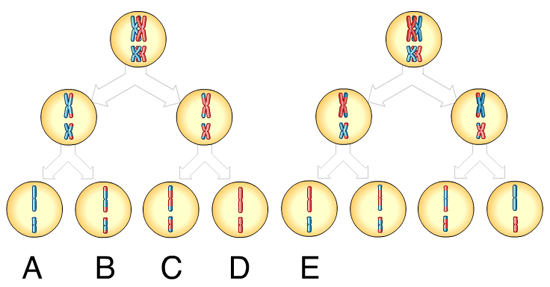
47)Which of these gametes contains one or more recombinant chromosomes?
A) A and B
B) B and C
C) A and D
D) D and E
E) A and C
B
48)A human cell containing 22 autosomes and a Y chromosome is
A) a sperm.
B) an egg.
C) a zygote.
D) a
somatic cell of a male.
E) a somatic cell of a female.
A
49)Homologous chromosomes move toward opposite poles of a dividing
cell during
A) mitosis
B) meiosis I
C) meiosis
II
D) fertilization
E) binary fission
B
50)Meiosis II is similar to mitosis in that
A) sister
chromatids separate during anaphase
B) DNA replicated before the
division
C) the daughter cells are diploid
D) homologous
chromosomes synapse
E) the chromosome number is reduced.
A
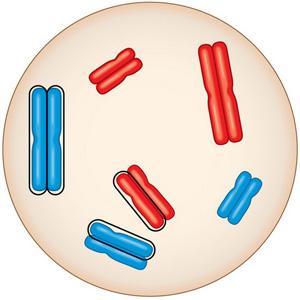
51)Look at the cell in the figure. Based on this figure, which of the following statements is true?
A)This cell is haploid.
B)This cell is diploid.
C)It is impossible to tell whether the cell is haploid or diploid.
B
52)Which life cycle stage is found in plants but not animals?
A)gamete
B)multicellular haploid
C)zygote
D)multicellular diploid
E)unicellular diploid
B
53)Why do some species employ both mitosis and meiosis, whereas other species use only mitosis?
A)A single-celled organism only needs mitosis.
B)They need meiosis if the cells are producing organs such as ovaries
C)They need only meiosis if they produce egg cells.
D)They need only mitosis to make large numbers of cells such as sperm.
E)They need both if they are producing animal gametes.
E
54) Nucleoli are present during _____.
A)metaphase
B)prophase
C)interphase
D)prometaphase
E)anaphase
C
55)During _____ both the contents of the nucleus and the cytoplasm are divided.
A)G2
B)the mitotic phase
C)mitosis
D)G1
E)S
B
56)During _____ the cell grows and replicates both its organelles and its chromosomes.
A)cytokinesis
B)interphase
C)mitosis
D)G1
E)S
B
57)Which of the following correctly matches a phase of the cell cycle with its description?
A)M: duplication of DNA
B)G1: follows cell division
C)G2: cell division
D)S: immediately precedes cell division
E)All of the above are correctly matched.
B
58)One difference between cancer cells and normal cells is that cancer cells
A)cannot function properly because they are affected by density-dependent
B)are arrested at the S phase of the cell cycle.
C)are always in the M phase of the cell cycle.
D)are unable to synthesize DNA.
E)continue to divide even when they are tightly packed together.
E
59)A particular cell has half as much DNA as some other cells in a mitotically active tissue. The cell in question is most likely in
A)metaphase.
B)anaphase.
C)G2
D)G1
E)prophase
D
60)The drug cytochalasin B blocks the function of actin. Which of the following aspects of the animal cell cycle would be most disrupted by cytochalasin B?
A)DNA synthesis
B)spindle formation
C)cleavage furrow formation and cytokinesis
D)spindle attachment to kinetochores
E)cell elongation during anaphase
c
61)Asexual reproduction _____.
A)produces offspring genetically identical to the parent
B)requires both meiosis and mitosis
C)is limited to plants
D)is limited to single-cell organisms
E)leads to a loss of genetic material
A
62)For what purpose(s) might a karyotype be prepared?
A)for prenatal screening, to determine if a fetus has the correct number of chromosomes
B)to determine whether a fetus is male or female
C)to detect the possible presence of chromosomal abnormalities such as deletions, inversions, or translocations
D)The first and second answers are correct
E)The first three answers are correct.
E
63)In alternation of generations, what is the diploid stage of a
plant that follows fertilization called?
A)
gametophyte
B) chiasmata
C) sporophyte
D)
karyotype
E) spore
C
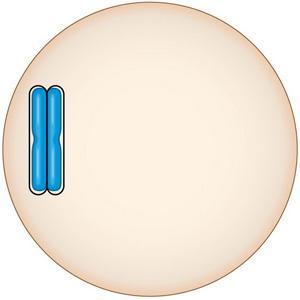
64)This chromosome has two chromatids, joined at the centromere. What process led to the formation of the two chromatids?
A)The two chromatids were formed by synapsis and the formation of a synaptonemal complex.
B)The two chromatids were formed by fertilization, bringing together maternal and paternal chromatids.
C)The two chromatids were formed by duplication of a chromosome.
C
65)Two sister chromatids are joined at the centromere prior to meiosis. Which statement is correct
A)These chromatids make up a diploid chromosome.
B) The cell that contains these sister chromatids must be haploid.
C)Barring mutation, the two sister chromatids must be identical
C
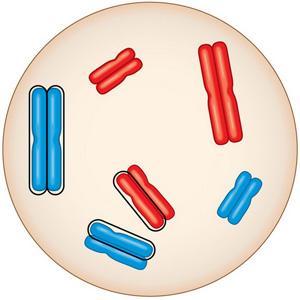
What is the best evidence telling you whether this cell is diploid or haploid?
A)The cell is haploid because the chromosomes are not found in pairs.
B)The cell is diploid because it contains two sets of chromosomes.
C)The cell is diploid because each chromosome consists of two chromatids
B
67)Identify all possible products of meiosis in plant and animal life cycles.
A)Gametes
B)Spores
C)Multicellular adult organisma
D) A AND B
D
81)What is crossing over?
A)-a direct consequence of the
separation of sister chromatids
B)-also referred to as the
"independent assortment of chromosomes"
C)-the movement
of genetic material from one chromosome to a nonhomologous
chromosome
D)-making an RNA copy of a DNA strand
E)-the
exchange of homologous portions of nonsister chromatids
E
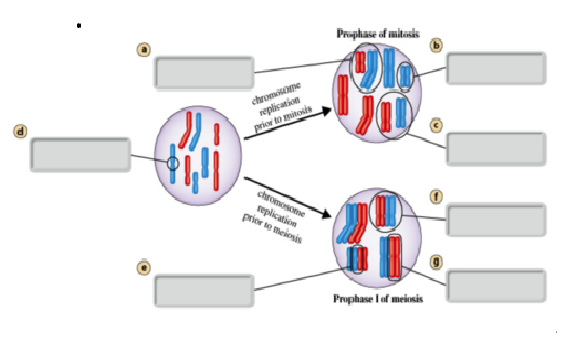
82)non-homologous chromosomes
A)
B)
C)
D)
E)
A

83) sister chromatids
A)B, G
B)C,F
C)A,B
D)F,C
E)E,A
A

84)homologous chromosomes
A)B, G
B)C,F
C)A,B
D)F,C
E)E,A
B

85) centromere
A)
B)
C)
D)
E)
D

86)nonsister chromatids
A)
B)
C)
D)
E)
E
87)Which of the following defines a genome?
A)-the complete set
of an organism's polypeptides
B)-the complete set of an
organism's genes
C)-a karyotype
D)-the complete set of a
species' polypeptides
E)-representation of a complete set of a
cell's polypeptides
B
88)Which of the following is true of a species that has a chromosome
number of 2n = 16?
A)-During the S phase of the cell cycle there
will be 32 separate chromosomes.
B)-A gamete from this species
has four chromosomes.
C)-The species is diploid with 32
chromosomes per cell.
D)-The species has 16 sets of chromosomes
per cell.
E)-Each cell has eight homologous pairs.
E
89)Assume that an organism exists in which crossing over does not occur, but that all other processes associated with meiosis occur normally. Consider how the absence of crossing over would affect the outcome of meiosis.
If crossing over did not occur, which of the following statements about meiosis would be true? Select all that apply.
A)The two sister chromatids of each replicated chromosome would no longer be identical.
B)Independent assortment of chromosomes would not occur.
C)There would be less genetic variation among gametes.
D)The two daughter cells produced in meiosis I would be identical.
C
90)The shuffling of chromosomes that occurs during both fertilization and _____ can lead to genetic variation.
A)natural selection
B)mutation
C)meiosis
D)genetic drift
E)mitosis
C
91)Heritable variation is required for which of the following?
A)mitosis
B)evolution
C)the production of a
clone
D)meiosis
E)asexual reproduction
b
92)Homologous chromosomes move toward opposite poles of a dividing
cell during
A)meiosis I.
B)fertilization.
C)meiosis
II.
D)mitosis.
E)binary fission.
A
93)Meiosis II is similar to mitosis in that
A)the chromosome
number is reduced.
B)the daughter cells are
diploid.
C)homologous chromosomes synapse.
D)sister
chromatids separate during anaphase.
E)DNA replicates before the division.
D
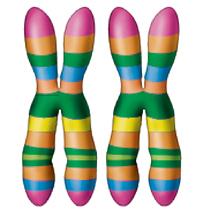
94)We can see that the chromosomes are duplicated and lined up by homologous pair.
A)the start of mitosis
B)just before mitosis
C)just before mitosis
D)the start of meiosis II
E)the start of meiosis I
E
95)Nucleotides can be radiolabeled before they are incorporated into
newly forming DNA and, therefore, can be assayed to track their
incorporation. In a set of experiments, a studentfaculty research team
used labeled T nucleotides and introduced these into the culture of
dividing human cells at specific times.
The research team
used their experiments to study the incorporation of labeled
nucleotides into a culture of lymphocytes and found that the
lymphocytes incorporated the labeled nucleotide at a significantly
higher level after a pathogen was introduced into the culture. They
concluded that _____.
A)infection causes cell cultures in general to reproduce more rapidly
B)infection causes lymphocytes to divide more rapidly
C)infection causes lymphocyte cultures to skip some parts of the cell cycle
D)the presence of the pathogen made the experiments too contaminated to trust the results
B
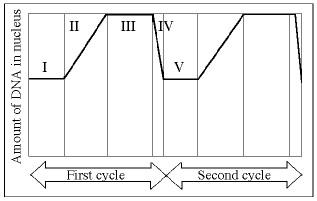
96)In the figure above, which number represents DNA synthesis?
A)I
B)II
C)III
D)IV
B

97)In the figure above, at which of the numbered regions would you
expect to find cells at metaphase
a)I or V
b)II only
c)III only
d)IV only
C
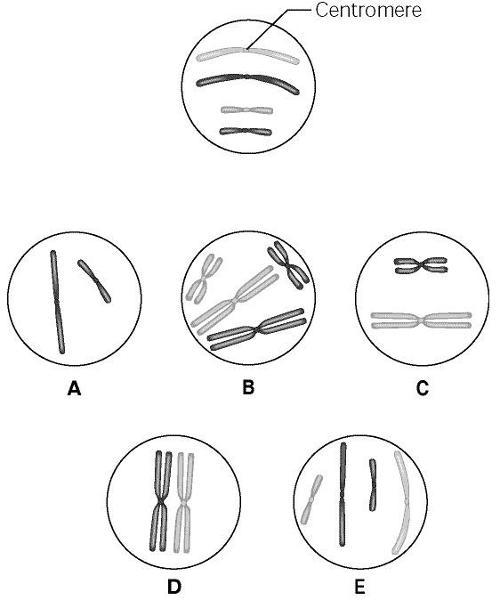
98)The unlettered circle at the top of the figure shows a diploid nucleus with four chromosomes that have not yet replicated. There are two pairs of homologous chromosomes, one long and the other short. One haploid set is black, and the other is gray. The circles labeled A to E show various combinations of these chromosomes.
25) What is the correct chromosomal condition at prometaphase of mitosis?
A) B
B) C
C) D
D) E
A

99)The unlettered circle at the top of the figure shows a diploid nucleus with four chromosomes that have not yet replicated. There are two pairs of homologous chromosomes, one long and the other short. One haploid set is black, and the other is gray. The circles labeled A to E show various combinations of these chromosomes.
26) What is the correct chromosomal condition for one daughter nucleus at telophase of mitosis?
A) B
B) C
C) D
D) E
D
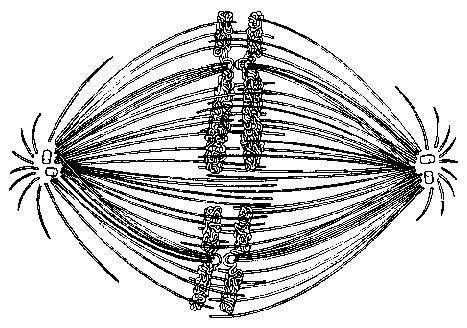
100)If the cell whose nuclear material is shown in the accompanying figure continues toward completion of mitosis, which of the following events would occur next?
A) spindle fiber formation
B) nuclear envelope breakdown
C) formation of telophase nuclei
D) synthesis of chromatids
C
88)A group of cells is assayed for DNA content immediately following mitosis and is found to have an average of 8 picograms of DNA per nucleus. How many picograms would be found at the end of S and the end of G2?
A) 8; 8
B) 8; 16
C) 16; 8
D) 16; 16
D
89)Metaphase is characterized by _____.
A) aligning of chromosomes on the equator
B) splitting of the centromeres
C) cytokinesis
D) separation of sister chromatids
A
90)If there are 20 centromeres in a cell at anaphase, how many chromosomes are there in each daughter cell following cytokinesis?
A) 10
B) 20
C) 40
D) 80
A
91)Taxol is an anticancer drug extracted from the Pacific yew tree. In animal cells, Taxol disrupts microtubule formation. Surprisingly, this stops mitosis. Specifically, Taxol must affect _____.
A) the structure of the mitotic spindle
B) anaphase
C) formation of the centrioles
D) chromatid assembly
A
92)Which of the following are primarily responsible for cytokinesis in plant cells but not in animal cells?
A) kinetochores
B) Golgi-derived vesicles
C) actin and myosin
D) centrioles and centromeres
B
93)Measurements of the amount of DNA per nucleus were taken on a large number of cells from a growing fungus. The measured DNA levels ranged from 3 to 6 picograms per nucleus. In which stage of the cell cycle did the nucleus contain 6 picograms of DNA?
A) G1
B) S
C) G2
D) M
C